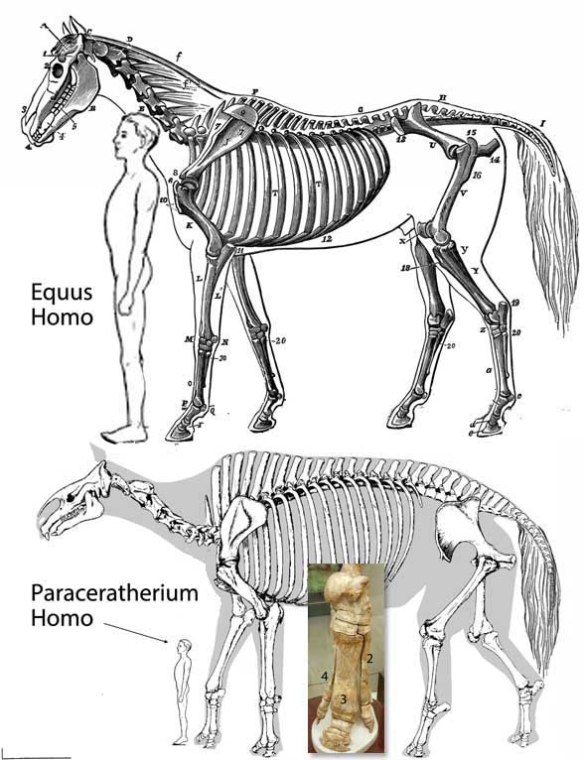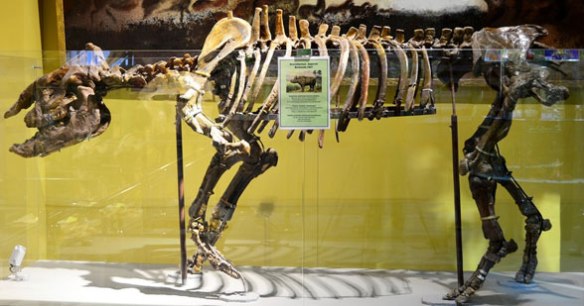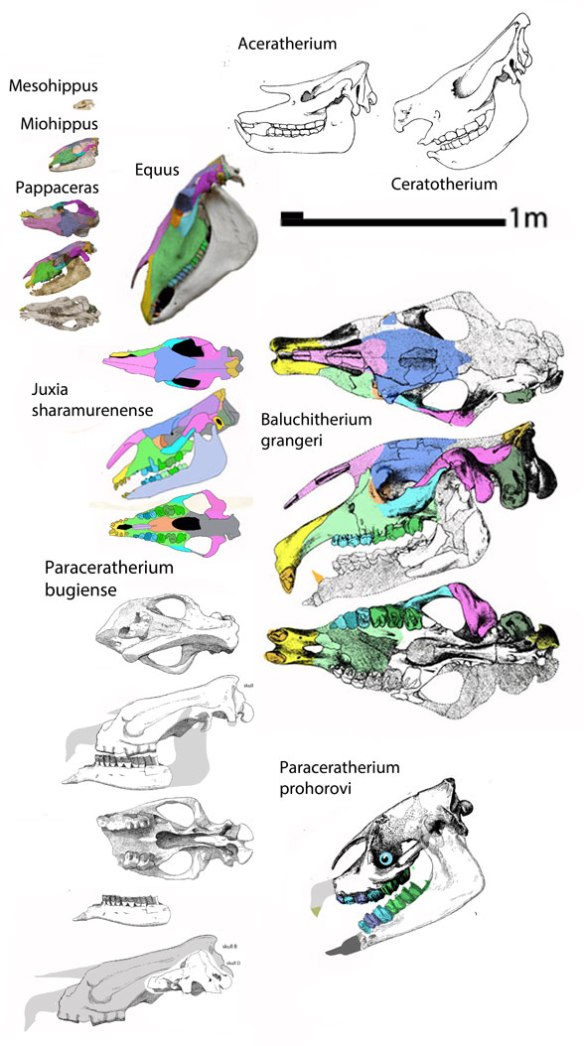Earlier the large reptile tree (LRT, 993 taxa) nested the traditional giant rhinos, Paraceratherium (Fig. 1) and Juxia, with the horses Equus (one toe, Fig. 1) and Mesohippus (three toes) based on several traits lacking in Ceratotherium, the extant white rhinoceros. This heretical hypothesis of relationships is not in the academic literature. Evidently dental details separate horses from rhinos. The LRT employs very few dental traits.
So today’s quandary involves convergence.
Do we trust the teeth that say indricotheres are rhinos?
Or are the teeth convergent?
Do we trust the rest of thel traits that say indricotheres are three-toed horses?
Or are all the non-dental traits convergent?
Adding taxa
has solved issues like this in the past. Today we add the basal rhino, Hyrachyus. We add a taxon considerd basal to the indricotheres, Pappaceras. And we add a basal horse, Miohippus (Fig. 3) hoping for resolution and consensus.

Figure 1. Equus the horse shares many traits with Paraceratherium. So is this a giant rhino-like horse? Or horse-like rhino?
First let’s go back to the literature…
I wrote to Dr. Don Prothero, a renown expert in rhinos, asking if he knew of any phylogenetic analysis that included both horses and rhinos and their last common ancestor. Since his answer did not include the title of any such paper, I went to his biography and found a few likely resources. Unfortunately the best of them (see below) predate the advent of software in phylogenetic analysis and often rhinos are tested separate from horses.
Prothero, Manning and Hanson 1986
describe a situation in which rhinos had been little studied. They report, “We have tried to straighten out some of the problems in rhinoceros relationships.” They open with a history of the study. “Osborn 1898 was the first to recognize our modern division of rhinocerotoids into three distinct families: Hyracodontidae (including giant indricotheres), Amynodontidae and Rhinocerotidae.” They presented a new hypothesis of relationships with a de-emphasis on dental traits. They employed Hyrachyus as their outgroup and did not include any horses. Their tree recovered Forstercooperia and Pappaceras (Fig. 2) as sisters to the indricothere clade and that clade a sister to the clade that included Hyracodon.
As a side note
Embolotherium, the titanothere currently nesting with the extant white rhino, did not make the rhino list of taxa.

Figure 2. Pappaceras is one of the closest known sisters to the indricotheres according to rhino cladograms. It nests between Mesohippus and Miohippus in the LRT (Fig. 3).
Basal to the indricotheres,
The Prothero, Manning and Hanson 1986 cladogram recovered:
- Rhinocerotoidea diagnosed on the basis of dental traits plus a cylindrical odontoid process on the atlas and a fused intervertebral canal on the atlas.
- Hyracodontidae had a tridactyl manus, long limbs and metapodials, laterally compressed carpus and tarsus.
- Paraceratheriinae (= Indricotheriinae) had a large size, enlarged lower P1; upper M3 metacone reduced, conical incisors.
When I add
Hyrachyus to the LRT it nests basal to the rhinos confirming the hypotheses of prior workers. Surprisingly Mesohippus did not nest with Miohippus and Equus in the LRT. Furthermore, Pappaceras did not nest with Juxia and Paraceratherium in the LRT. Close… but the clades did not separate into rhinos and horses… and indricotheres did not nest with Hyracodon and the rhinos.

Figure 3. Subset of the LRT focusing on the hyracotheres, including horses and rhinos. Traditional rhinos are in light green. Traditional horses are in tan. Is this the result of convergence or taxon inclusion?
Prothero et al. 1988 reported
“Hyraxes are closer to perissodactyls than to elephants and sirenians. Perissodactyls are closer to whales and elephants than they are to artiodactyls.” The LRT does not support those findings.
re: Miohippus
Wikipedia reports, “Miohippus also had a variable extra crest on its upper molars, which gave it a larger surface area for chewing tougher forage. This would become a typical characteristic of the teeth of later equine species.”

Miohippus skull and skeleton. Is this a sister to the ancestor of horses and indricotheres? Compare the foot the that of Paraceratherium (Fig. 1).
And…
“Miohippus had two forms, one of which adjusted to the life in forests, while the other remained suited to life on prairies. The forest form led to the birth of Kalobatippus (or Miohippus intermedius), whose second and fourth finger again elongated for travel on the softer primeval forest grounds. The Kalobatippus managed to relocate to Asia via the Bering Strait land bridge,”
That’s all it takes
|to start a new clade. Wikipedia reports, “Kalobatippus ate leaves and was characterized by unusually long legs.”
Summary
Let’s consider the possibility that indricotheres could be horses with rhino-like teeth, perhaps due to a similar herbivorous diet. Perhaps this result will stimulated further interest in the subject.
References
Marsh OC 1874. Notice of new equine mammals from the Tertiary formation. American Journal of Science 7(39):247-258.
Prothero DR, Manning E and Hanson CB 1986. The phylogeny of the Rhinocerotoidea (Mammalia, Perissodactyla). Zoological Journal of the Linnean Society 87:341-366.
Prothero DR, Manning EM and Fischer M 1988. The phylogeny of the ungulates Pp. 201-234 in The phylogeny and classification of the tetrapods, volume 2: Mammals (ed. Benton MJ) Systematics Association special volume 35B:
Wang H, Bai B, Meng J and Want Y-Q 2016. Earliest known unequivocal rhinocerotoid sheds new light on the origin of Giant Rhinos and phylogeny of early rhinocerotoids. Nature Scientific Reports 2016.
Wood H E 1963. A primitive rhinoceros from the Late Eocene of Mongolia. American Museum Noviates 2146:1–11.
wiki/Miohippus




















